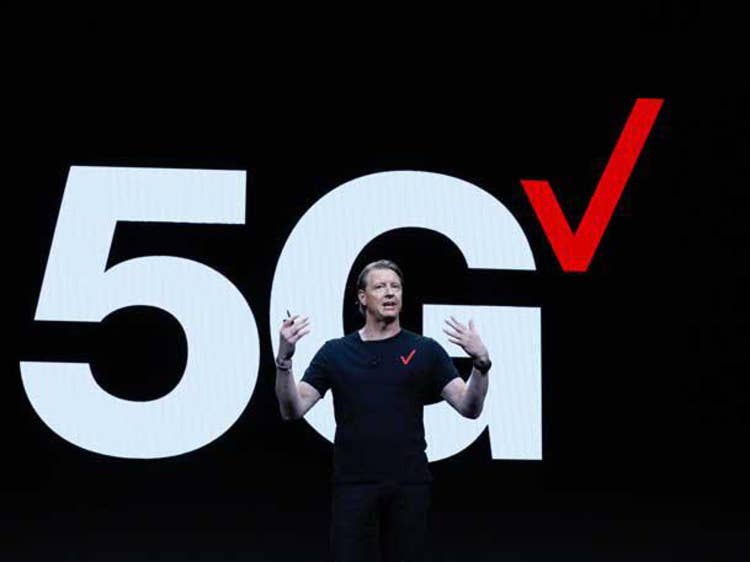5 Big Things To Know About Verizon’s Q1 Earnings
From ‘once in a lifetime’ 5G spectrum buys, to growth in business services, here’s what you need to know about Verizon’s Q1 2021 results.

Bouncing Back
Telecommunications giant Verizon this week posted Q1 2021 earnings that topped estimates, driven by strength in its core product: the network.
Revenues were up 4 percent overall, a solid hike following a difficult year for many companies due to the COVID-19 pandemic. In fact, CEO Hans Vestberg (pictured) said that the carrier had growth in all businesses for the first time since the launch of Verizon 2.0. Business services, for the first time in several quarters, posted growth, including a double-digit bump in public sector revenues. Verizon also touted its 5G footprint expansions and the investments it’s making to be a leader in next-generation wireless. At the same time, however, the consumer business saw some weakness as the carrier lost postpaid subscribers during the quarter.
Basking Ridge, N.J.-based Verizon has been working through a company-wide business and executive team restructuring and its Voluntary Separation program since 2019, which included early-retirement buyout deals to thousands of its employees in an effort to achieve $10 billion in cumulative cash savings by the end of 2021. The company this week announced that it has achieved its cumulative cash savings goal, well ahead of its year-end 2021 target.
From strength in business services, to consumer declines, to looking ahead to 5G, here are Verizon’s Q1 2021 financial results.
The Results
For the first quarter of the year, which ended March 31, Verizon reported operating revenues of $32.87 billion in the quarter, up 4 percent from $31.61 billion in Q1 2020. Verizon attributed the growth during the quarter to strength in Fios, and with Fios Internet reporting the best first quarter net adds in six years, Vestberg said.
The carrier’s net income grew 25.4 percent in the quarter to $5.38 billion, up from $4.29 billion during the same period last year. Verizon reported adjusted earnings per share of $1.27 cents, up compared to adjusted earnings per share of $1.00 during first-quarter 2020.
Business Solutions
The Verizon Business segment includes the company’s Global Enterprise Solutions, small and mid-size business, public sector, and wholesale businesses. The segment rose slightly by 1.3 percent, with revenues climbing to $7.78 billion during the first-quarter of 2021 compared to $7.68 billion in the year-ago period.
Global Enterprise revenues, however, continued to decline, dipping 2.7 percent to $2.56 billion in revenue in Q1 2021, compared to $2.63 billion in the first quarter of 2020. SMB revenue stayed relatively flat at $2.83 billion during Q1 2021, up from $2.80 billion in the year-ago period. Public Sector saw double-digit growth of 11.7 percent to $1.65 billion during the quarter, up from $1.47 billion. Wholesale revenues continued to slide downward, falling 3.4 percent to $746 million in the first quarter of 2021 from $773 million in Q1 2020.
5G
Verizon has been heads-down focused on network investments and 5G for the past several quarters, and Q1 2021 was no different. Vestberg said that the carrier has brought 5G service to several additional cities during the quarter, with 30 5G home and 67 5G mobility cities live today. The CEO promised more cities and geographies will be lit up with 5G, and that Verizon recently signed its first European private 5G deal with Associated British Ports. The carrier also expanded its 5G edge partnership with AWS for private 5G and edge computing.
Verizon said that it has ordered half of the total network equipment needed from its 5G suppliers to support C-Band deployments in 2021. Verizon has begun deployment of its 5G Ultra Wideband and fixed wireless broadband service on C-band spectrum, which the carrier bought earlier this year in what Vestberg referred to as a “once-in-a-lifetime opportunity.”
Wireless Results
While business services are on the upswing and 5G growth has blossomed, the first quarter of the year presented weakness in the telecom giant’s wireless subscriber base as Verizon felt the sting from the competition, AT&T and T-Mobile.
In Verizon’s consumer business, the company posted 326,000 retail postpaid net losses, including 225,000 customers using smartphones. Verizon’s total retail postpaid churn was 0.97 percent, while retail postpaid phone churn was 0.77 percent. Despite the losses, Verizon said that its consumer wireless service revenue came in at $13.7 billion, up 1.5 percent from a year earlier, “driven by the continued adoption of wireless unlimited and premium unlimited plans.”
COVID-19 Impact
Unlike Q1 2020 financials, which started to see a substantial impact from the global COVID-19 pandemic, the first quarter of 2021 marked a recovery period for Verizon, which like many companies, is bouncing back from the financial hit of the pandemic that resulted in an economic downturn.
“With the positive momentum exiting the first quarter and the ongoing recovery of business activity, we are highly confident that our actions in the marketplace will deliver strong results throughout the year,”
said Matt Ellis, Verizon’s executive vice president and CFO.